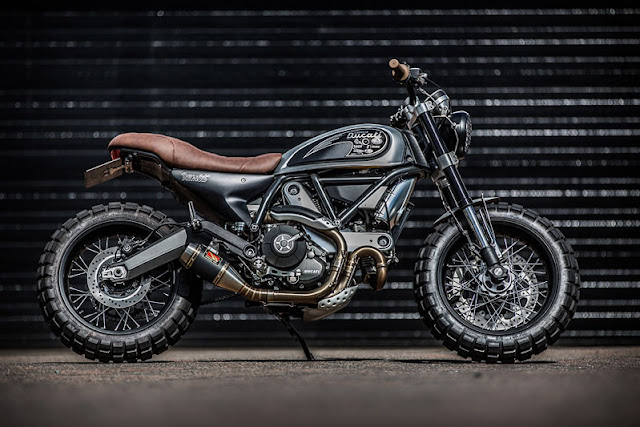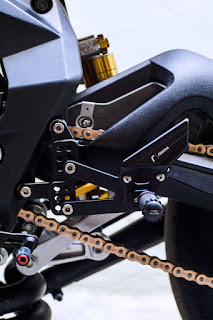Beindruckendes
Bike!
Aber
lest selbst
Reinventing
Adventure with BCR’s Redesign of BMW R1200 GS
THE
PITCH
After
BCR’s February 2016 launch of “Velocita D’epoca,” the BCR
Team was approached by one of our friends to build a bike.
Initially, they wanted to use the new Ducati Scrambler as a donor
bike, but we told them to choose something more size appropriate for
his build. The Scrambler is a small bike and the guy is 5’11”.
If we used the Scrambler as a base for our build, his relative size
alone would visually overshadow the bike. Despite the Scrambler’s
popularity in custom bike builds, we wanted to use something
different – as always, we wanted to do something that most bike
shops wouldn’t. Our goal was to make the rider look good, visually
proportional, and in aesthetic harmony with the bike. After a bit of
thought, we suggested a BMW R1200 GS.
The
GS is perfect for his height and his preferred riding position. Our
friend has a busy schedule and it was imperative that we build a
reliable bike that he could easily start and ride. The R1200 GS is a
well-known adventure bike, but a lot of custom bike shops stay away
from using it as a platform build due to its size (it’s pretty
big).
Initially, I, too was hesitant to use an R1200 GS as the
base for this build. This bike is an adventure-seeking, off-road
motorcycle, which I knew was not the kind of bike our friend would
prefer. When we build bikes, we want the bikes to reflect the
personalities of their owners. To me, our friend was more of an urban
rider who would mostly use this bike in the city or on long country
road trips. Knowing that the GS was never built for this kind of
terrain became the deciding factor in our decision to build a more
suitable R1200 GS, and we hoped that having a GS might even entice
him to go through rough gravel roads he may not have ridden on
before. It has always been part of our nature to build bikes
that deviate from what’s expected, so we decided to make the GS
look like a stripped-down, exposed, and robotic build from the
post-apocalypse – a build that I felt was perfect for the GS’
unique Telelever and Paralever suspension.

THE
SEARCH
We
finally sold our friend on the idea of using the GS and (through the
divine powers of networking) were able to find a decent 2005 model.
The bike had 30,000 miles on it and signs that it had been dropped a
few too many times, but that wasn’t a problem for us. As I’ve
stated before, the GS was built with the spirit of adventure in mind
and the wear and tear was expected. The plastics were cracked
and the front wheel had a flat spot, but the motor, transmission,
rear differential, and suspension seemed useable. Once we had
the bike in our shop, we stripped it down to a rolling frame – we
scrapped the tank, fairing, seat, exhaust, and the fenders.

THE
PROCESS
Once
we took the body panels off, we noticed how the frame was awkwardly
upswept and was generally too long for what we had in mind.
Because of this, we cut the tail part off of the frame and fabricated
a sub-frame. We also added frame rails running from the
steering neck that curved down to the mid-section of the frame,
similar to how the ’70s BMW R model frame rails were.
Modifying
the frame led us to change the position of the handlebars.
The bike we had in mind existed without a fairing, leaving the
handlebars openly exposed, and the stock swept-back position didn’t
strike as aggressively as we thought it could. We opted to use
low rise pro taper bars and fabricated a metal plate that moved the
handlebars further back on the upper trees. Once we had the
handle bars all set up, we started fabricating our rendition of an MX
number plate out of aluminum. Because of the GS’ Telelever
front suspension, the lower tree is all the way down to the front
tire. To work around this, we hand-milled a 1/2″ aluminum
plate and secured it to the upper tree. To keep with the
exposed theme of this build, we shaped the bracket like a fang.
We then added detail to the bracket and made holes to maintain a
lower weight. With urban driving in mind, we mounted the
headlight off center toward the left to make the bike more noticeable
to oncoming traffic. We wanted the finished build to contain as
few original parts as possible, so we removed the plastic front
fender and fabricated a new one out of aluminum. We mounted the
front fender a little higher to provide a more aggressive look than
the stock front fender, which was mounted closer to the front tire.
To do this, we split the fender in half and mounted the fender to the
front and back of the lower fork brace as opposed to under the lower
fork brace. The fender brackets were made out of aluminum plates with
added holes to match the number plate fairing.

THE
DETAILS
After
we finished the front end, we moved on to the gas tank, which to us,
is the focal point of any bike. The shape of the gas tank is
always what dictates the overall look and attitude of our bikes.
Originally, the GS comes with a massive 8-gallon tank to fuel its
adventurous nature. On this build, however, we realized that a
large tank was unnecessary and an inefficient use of space. In
homage to the old school, we decided to shape the tank similarly to
the toaster tanks of the ’70s BMW airheads. We added knee
indents, machined rubber knee pads, and put tank badges on the
sides. The stock EFI fuel pump on the GS was perfect for the
post-apocalyptic look that we were after. We had the EFI fuel pump
assembly mounted on top, and exposed the hoses and wires that power
up the internal pump. Just like any of our full bike builds, we
left the tank bare- aluminum with a polished-finish and added simple
black scallop graphics with gold pinstripes.
After
the tank was set up we swung our focus to the back of the bike; the
seat and the rear fender. We hated the idea of a flat,
box-shaped seat & shaped the new one with a curvier look that
blended the front of the seat with the tail of the tank to provide a
sleep tank-to-seat transition. We then wrapped the seat in
black Alcantara upholstery with a simple bead stitching across the
seat. We shaped the tail light to seem as though it were part
of the seat and added slots that matched the bead stitching for the
light. We then shaped the aluminum rear funder similarly to the shape
of the tank.
With
“aggressive” in our minds, we designed the exhaust as a 2-into-2
high mount exhaust with exposed welds. We ran the pipes on top of the
left-side cylinder and tucked it in to provide more leg area to the
rider. The exhaust then exits to the back of the rider’s
leg. We added springs mostly to hold everything up, but also to
give the exhaust a mean-looking detail. The mufflers were
glass-packed and shaped similarly to the dirt tracker exhaust of the
’70s. We finished that section by adding a couple of head
shields to protect the rider from the added heat.
When
we purchased the GS, it only had 30,000 miles. It was still
impressively strong, so all we did was rebuild, reseal, and swap out
the top end gaskets to make sure nothing leaked. We replaced
the clutch and gave it a tune-up then realized that we didn’t want
to use the stock air box. Instead, we wanted something that
would open up the frame. We didn’t want to just slap on an
aftermarket filter at the end of the throttle body either, so we
fabricated a tube that moved the air filter inside the frame.
The front of the motor on the GS had a plastic cover, but we didn’t
want to attract attention to the motor. Using the old plastic
cover as a mold, we made a new front cover out of carbon fiber and
added a BMW badge. When we removed the fairing, we removed the
mount for the oil cooler so we then had to relocate the oil cooler to
the right side of the bike and added an air deflector to push hot air
coming from the oil cooler away from the rider’s leg.
We
didn’t like how the stock foot pegs were mounted and wanted
something that looked more detached so we ended up getting rid of the
factory tube brackets and fabricated brackets out of stainless rods
that were hung under the frame. We also fabricated our own foot
pegs out of stainless plates with milled tops to add grip to the
rider’s boots. We didn’t want the rear brake master
sticking out at the back of the foot pegs so we mounted it up front
underneath the motor and fabricated a linkage-less foot pedal to keep
things simple and clean.
MISSION
ACCOMPLISHED
Just
like any project at BCR Designs, we’re meticulous at every step of
the project. We listen to our clients and only create products that
we ourselves will use. We make everything by hand, in-house and we
make sure that form follows function. We always try to create
something that we believe is original and a combination of beauty and
efficiency.
 Rund
1.000 Herstellern aus aller Welt, über 200.000 Fachbesuchern,
Motorradbegeisterten und Medienvertretern aus mehr als 100 Ländern
ist die INTERMOT ganz klar Pflichttermin für die gesamte
Motorrad-Branche. Ein tolles Rahmenprogramm mit den
coolsten Neuvorstellungen, spannenden
Sprints der Bikes der ESSENZA (in Kooperation mit Glemseck 101) und
die SULTANS OF SPRINT. Schaut euch die FMX-Show an und oder seit bei
der NIGHT OF JUMPS dabei. Seit dabei, wenn die schönsten Motorräder
der Leserwahl der MOTORRAD oder die spektakulären
Einzelanfertigungen der AMD „World Championship of Custom Bike
Building“ prämiert werden.
Rund
1.000 Herstellern aus aller Welt, über 200.000 Fachbesuchern,
Motorradbegeisterten und Medienvertretern aus mehr als 100 Ländern
ist die INTERMOT ganz klar Pflichttermin für die gesamte
Motorrad-Branche. Ein tolles Rahmenprogramm mit den
coolsten Neuvorstellungen, spannenden
Sprints der Bikes der ESSENZA (in Kooperation mit Glemseck 101) und
die SULTANS OF SPRINT. Schaut euch die FMX-Show an und oder seit bei
der NIGHT OF JUMPS dabei. Seit dabei, wenn die schönsten Motorräder
der Leserwahl der MOTORRAD oder die spektakulären
Einzelanfertigungen der AMD „World Championship of Custom Bike
Building“ prämiert werden.






















































